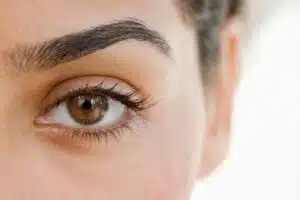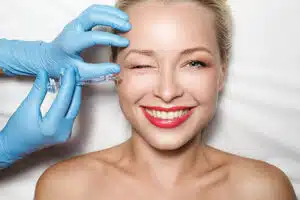Would you like to even out the texture of your skin? Smooth out certain wrinkles, reduce acne scars, fade a visible scar or reduce the appearance of pigmentation spots? Chances are that a fractional laser treatment is the answer to your needs. Very safe when performed by professionals, fractional lasers are gaining in popularity due to their great effectiveness in treating a wide range of skin problems. And because it is important to avoid exposure to the sun after this type of treatment, Fall is the perfect time to get one. Which laser is right for you? Find out with this guide!
What are fractional lasers?
Fractional lasers have been used for more than 15 years in aesthetic medicine to treat various skin problems such as spots and texture. Their name comes from the fact that only a predetermined part of the skin is targeted during the treatment. In this way, generally more than three-quarters of the skin surface remains intact, allowing for an effective stimulation of dermal and epidermal regeneration and a much shorter recovery time than with first generation resurfacing lasers. These lasers work, depending on the goal to be achieved, by creating precisely spaced microperforations at specific depths. As the surrounding tissue is preserved, the skin recovers much more quickly. The skin’s self-healing mechanism renews collagen and activates the production of new healthy epidermal cells, replacing damaged tissue. The result? A renewed and firmer skin with reduced wrinkles, spots and scars and faded stretch marks.
Types of lasers
Fractional lasers are divided into three categories: ablative, non-ablative and hybrid, depending on the type of energy they deliver. The power (joules), wavelength (nanometers) and warm-up time (milliseconds), depth and degree of coagulation are all parameters to be considered according to the technology chosen. Although they treat essentially the same skin conditions, they do so at very different levels. The parameters will therefore be adjusted according to the patient’s concern(s) and skin type. Despite the fact that the recovery time and the skin’s ability to regenerate vary significantly from one person to another, the choice of the type of laser is definitely to be taken into account when planning the expected recovery and the results to be obtained. These aspects will be addressed by the specialist who will help you establish your treatment plan.
1. ABLATIVE LASERS
With long wavelengths (between 2,940 and 10,600 nanometers), ablative fractional lasers break the epidermal barrier to reach the dermis in order to heat and locally alter a predefined fraction of the epidermis. This deep action allows the targeted tissues to regenerate and increase the production of fibroblasts, the producers of collagen and elastin. They are very effective but require a much longer recovery time (about 10 days).
What do they treat?
This type of laser is used to treat more severe skin conditions, such as pronounced wrinkles around the mouth, deep acne scars and deep-seated body stretch marks. Numerous and widespread pigment spots can also be greatly reduced with this type of laser to reveal a much brighter complexion and a finer skin texture. It can be used on most areas such as the face, neck, décolleté, arms, hands, legs and stomach.
What you need to know
As the impact of the treatment is greater, recovery requires a longer period, usually lasting a minimum of 7 to 10 days. Sunburn-like redness and slight bleeding and oozing are to be expected at the beginning. Swelling of varying degrees and sometimes even the formation of small crusts, followed by desquamation of dead cells, is to be expected during the healing process, before the skin is completely restored. It is therefore essential to follow the post-treatment procedure rigorously and to apply a moisturizing and repairing care protocol in order to increase the chances of optimal healing. This type of laser can be used on very light, light and medium light skin types (phototypes I to III). For phototypes IV, V and VI, there is a risk of skin discoloration, but different treatment options are possible, to be discussed with one of our specialists.
The results
Although the recovery time is significant, this type of laser is also the most effective. Firmer, clearer skin and a considerable reduction in wrinkles and scars are generally noticed. In addition, although several treatments are usually required to obtain optimal results, a single treatment can sometimes produce impressive results and thus greatly encourage the continuation of the established treatment plan.
Where can I obtain this type of treatment?
Clinics in Quebec City, Beauport, Sherbrooke, Chicoutimi, Vancouver, Saskatoon and Kelowna offer this type of laser treatment*.
*The brand and specificity of the laser may vary from one clinic to another.
2. NON-ABLATIVE LASERS
In contrast to fractional ablative lasers, non-ablative lasers preserve the epidermal barrier with wavelengths ranging from 1440 to 1927 nanometers. The targeted dermal tissue is heated, but unlike ablative lasers, the epidermis remains intact. The risk of hypopigmentation or hyperpigmentation is very low. They can be used on all phototypes. They are gentler and effective, and their healing time is also shorter.
What do they treat?
Depending on the laser used, it is possible to treat various conditions such as pigment spots, wrinkles, fine lines, scars and some stretch marks. These lasers improve the overall appearance of skin tone and provide effective pore tightening. They are generally used to treat the skin on the face, neck, décolleté and hands and sometimes also on the stomach and thighs.
What you need to know
As these are less invasive lasers, more sessions are often required to achieve optimal results. In addition, the concerns treated by this type of laser are generally less intense than those targeted by ablative lasers. It is therefore important to discuss this with your consultant when developing a treatment plan so that you can choose the technology that best suits your needs. Recovery time can range from approximately 24 hours to 5 to 7 days depending on the laser chosen.
The results
Although considered less aggressive, this type of laser is very effective and we notice very interesting results in terms of overall complexion and pore tightening. To obtain optimal results and depending on what you wish to correct, a series of 3 to 6 sessions spaced 2 to 6 weeks apart are generally recommended, depending on the laser chosen.
Where can I obtain this type of treatment?
Clinics in Saint-Lambert, Laval, Montreal, Quebec City, Beauport, Sherbrooke, Ottawa, Toronto, Vancouver and Chilliwack offer this type of laser*.
*The brand and specificity of the laser may vary from one clinic to another.
3. HYBRID LASERS
By combining non-ablative and ablative laser technology, hybrid lasers can treat the epidermis and dermis separately in the same treatment. This allows controlled coagulation zones to be created at well-defined skin depths and maximizes overall results.
What do they treat?
They are used to reduce the appearance of fine lines and wrinkles, scars, stretch marks and sun damage as well as to improve overall skin texture and dilated pores. In addition to the face, skin on the neck, décolleté, arms, hands and legs are regularly treated.
What you should know
Ideal for normal and thin skin, this type of laser has the advantage of being more comfortable and requiring less recovery time than an ablative laser. Down time will depend on the intensity of the treatment as well as the skin’s ability to heal and is generally estimated at 3 to 4 days. They can be used on light to dark skin types, but extra care should be taken when treating high phototypes (IV, V and VI) to avoid depigmentation.
The results
An improvement in overall skin tone, tone and texture is noticed. The skin appears rejuvenated with a new radiance. One to two sessions are usually required to achieve the desired results.
Where can I obtain this type of treatment?
Clinics in Longueuil, Beauport, Calgary and Kelowna offer this type of laser*.
*The brand and specificity of the laser may vary from one clinic to another.
How to prepare for a laser treatment
Following your consultation and in preparation for your first treatment, your consultant will give you a document explaining all the recommendations related to the laser chosen. As a general rule, you should avoid the use of certain types of cosmetic ingredients such as retinoids and glycolic agents for at least ten days before the procedure. It is also advisable to avoid direct exposure to the sun or tanning booths and not to apply self-tanning products for at least a week before your treatment. If you are prone to cold sores, you will probably be advised to take anti-viral medication before your appointment. Some medications, especially those that are photosensitizing, should generally be avoided, but since you will have the opportunity to discuss your medical history beforehand, you will be given instructions well in advance of your appointment. If you have any questions or concerns, please do not hesitate to contact your clinic staff, they will be happy to help you!
How a session unfolds
It is strongly recommended that you come to your appointment without makeup.
1. One generally begins with the application of a lidocaine-based anesthetic gel on clean skin, which is left to act on the skin for a period varying from 20 minutes to 1.5 hours in order to make the treatment more comfortable. Before the treatment and during the pause of the anesthetic gel, the follow-up and post-treatment procedure specific to each type of laser are scrupulously explained and certain products to be used in post-treatment can be recommended.
2. The gel is then removed and the skin is disinfected with isopropyl alcohol to create a clean and sterile canvas before starting the procedure.
3. Goggles suitable for the chosen technology are fitted to protect the patient’s eyes.
4. The parameters are set according to what is to be corrected and the patient’s skin type.
5. The technician or physician then begins the treatment by sliding the applicator tip onto the skin. Although the procedure may vary from one technology to another, overlapping and repeating passes are possible. This can cause a strong heat sensation and make the treatment relatively uncomfortable. Especially with ablative lasers (Co2 and ProFractional®), bleeding and oozing of the skin may occur. A session rarely lasts more than an hour and every effort is made to minimize discomfort during the treatment.
*Some steps may differ slightly between lasers
Possible side effects
The first 48 hours (and the first night) are generally the most uncomfortable and require a great deal of diligence in terms of care. Depending on the laser used, swelling, redness and sometimes even slight bleeding, oozing and scabbing are to be expected, but these symptoms will gradually diminish over the five to ten days following the treatment. A normal desquamation of the skin occurs at the end of the recovery period and sunlight, make-up and all scented products should be avoided at all costs until the skin is completely healed. Major complications are rare, but it is important to follow the post-treatment recommendations carefully and to the letter so that the skin heals in the best possible conditions.
Taking care of your skin after treatment
Post-treatment recommendations will vary depending on the type of laser used. While for a milder laser, it will be possible to wash your face the same day and apply make-up the day after the treatment, the protocol will be very different for an ablative laser. As a general rule, the use of non-abrasive and non-scented products is recommended. Following the treatment, a serum based on vitamin C or hyaluronic acid may be suggested. It is important to respect the prescribed time before starting to use them. Moisturizing treatments applied several times a day may also be necessary. It will be of the utmost importance to stay out of the sun until the skin is completely healed and even beyond! Remember, you have a new skin, so it is imperative that you meticulously protect it so that your results can last. A mineral sunscreen, ideally SPF50 is recommended at all times following this type of procedure.
Our 4 star products for an optimal recovery
Functionalab Cleanser and Toner, $35
SkinCeuticals C E Ferulic Serum, $190
Functionalab Pre/Post-Treatment Cream 2, $100
SkinCeuticals Physical Fusion UV Defense SPF50 Fluid Sunscreen, $49
Contraindications
Women who are pregnant or breastfeeding should postpone this type of treatment. Certain treatments for severe acne that have been received within the last 6 months may also be a contraindication. In addition, an active cold sore is a systematic contraindication to all facial treatments. There are other considerations depending on the laser chosen.
When will the results be visible?
For most patients, depending on the laser used, the first improvements are apparent two to five days after the first session. However, the results are more visible after a full cycle of regeneration of the skin cells, that is, after a period of three to four weeks. The complete results will take a good twelve weeks after your last treatment before they are visible. Therefore, in the case of a cure, patience is required, but the condition of your skin will improve after each treatment before reaching the goal you have defined in your treatment plan.
For more information on the treatments offered, contact your favourite Dermapure clinic today!






